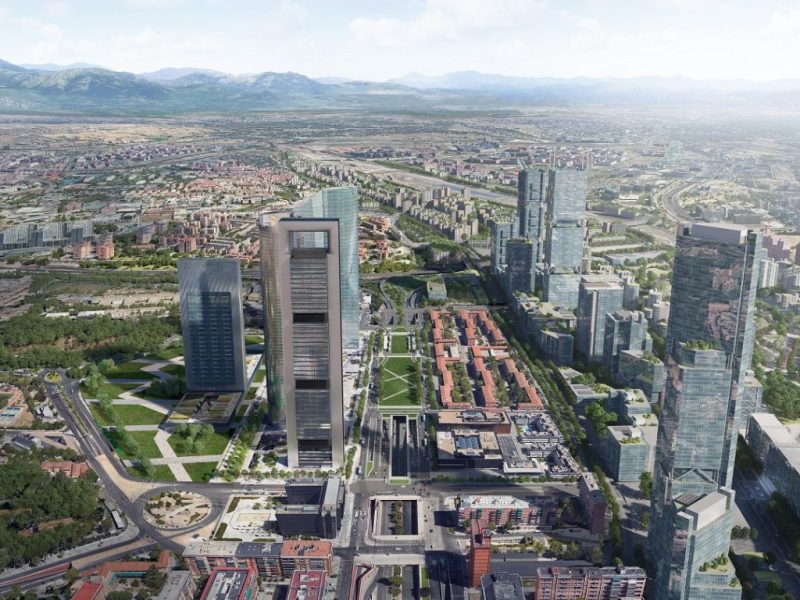21 March 2019
for Madrid Nuevo Norte


Madrid’s City Council will cover the final section of Castellana Avenue at the same time as the Madrid Nuevo Norte project, which has been given the initial approval.
Although previous versions of the project were entitled “Extension of Castellana Avenue”, the current project no longer includes an extension of the emblematic promenade in Madrid, at least not as a road for vehicular traffic. Instead, it will be extended north of the M-30 ring road to the foothills of El Pardo as a green corridor for pedestrians and cyclists.
South of the M-30 ring road, the middle segment of the last section of Castellana Avenue, at the intersection with Manuel Caldeiro and Arzobispo Morcillo streets, will be covered, and most road traffic will be undergrounded, as recently mentioned in the newspaper Expansión. The Madrid City Council will carry out the works at the intersection of Castellana Avenue and Nudo Norte (Madrid Northern Interchange), close to Cuatro Torres.
This one-hectare landscaped space, approximately 200-metres long and 50-metres wide, will be situated over the covered area, between Cuatro Torres and Colonia San Cristóbal housing estate. This new green space will encourage pedestrian traffic and urban continuum in an east-west direction, removing the physical barrier of the avenue itself.
This action, the details of which are included in the ad hoc modification of the General Plan currently under review, will involve the reorganisation of traffic along Castellana Avenue from its intersection with Sinesio Delgado Street. The area at street level is earmarked for the new intermodal public transport hub, across from La Paz Hospital, and for several side lanes, on both sides of the road, for local traffic.
One bus lane will be maintained in each direction, plus three lanes for vehicular traffic: one to the north and two to the south. Most traffic along Castellana Avenue will be routed below ground, connecting directly with the M-30 ring road, M-607 and M-11 roads and A-1 motorway. It will have access ramps starting from the Sinesio Delgado crossing. These works will also allow vehicular traffic in the east-west direction, crossing Castellana Avenue to both the north and south of the covered section.
Likewise, the project is expected to link with the Nudo Norte (Madrid Northern Interchange) junction. The City Council will carry out these works. The second phase of this redevelopment includes a new branch diverging from the main Castellana Avenue tunnel, connecting with Llano Castellano Avenue, next to Begoña district.
The project will bridge the existing gap void in the area caused by the width of Castellana Avenue and its fast-flowing traffic, which makes it impassable for pedestrians, and will mitigate noise and air pollution. Currently, there is only one underground pedestrian crossing; however, the users deem it unsafe.
The creation of the new La Paz Intermodal Hub, at the intersection of Castellana Avenue and Arzobispo Morcillo Street, with an estimated capacity for six bus docks, both interurban and urban, also gives meaning to this project.
This intermodal transport hub will have an estimated capacity for four buses in each direction and will reorganise the traffic of nearly 40 intercity bus lines currently operating in the area: 35 during the daytime and five at night. The hub will be located next to Begoña metro station (line 10), and several urban bus stops.
The new infrastructure will substantially improve the operation of existing intercity buses in the area, making it easier to switch between Metro, urban and intercity buses. This hub will be built next to La Paz University Hospital, a vital focal point for the citizens of Madrid.
It will be located some 350 metres from the future Metro station and bus stops of Madrid Nuevo Norte Business District. Together with the other infrastructures, it will shape the La Paz-Business District transport hub.
This operation will improve the quality of Madrid’s public transport in this transition zone to high-capacity roads such as the A-1, M-11 and M-607, and expand the existing public transport infrastructure of Madrid Nuevo Norte. All told, Madrid Nuevo Norte will have three new Metro stations, a new commuter train station and a fully renovated Fuencarral station, plus the new, trendsetting Bus Rapid Transit line. Chamartin Station will also be fully renovated within the new railway complex that will be built by the Ministry of Public Works, and the Regional Government of Madrid will construct the new, large Chamartín Intermodal Hub, next to the new station.